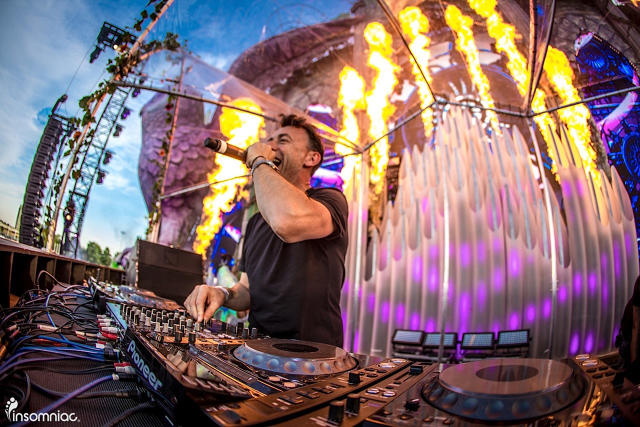Electronic Dance Music Is Hot, And Here’s the Data To Prove It
Hundreds of thousands will flock to the Electric Daisy Carnival this weekend. They stream a ton of dance music, but don’t buy so much.
When electronic dance music heavyweights like Calvin Harris, Martin Garrix, Bassnectar, Afrojack, and dozens of others take the stage this weekend in Las Vegas in front of hundreds of thousands of ravers at the Electric Daisy Carnival, it’ll be the physical manifestation of a music genre that has driven more than 11.2 billion streams since this time last year.
For decades, Nielsen has been the unofficial analyst of the entertainment industry, providing the data that tells us how many people are watching TV shows or listening to different kinds of music. Today, at the EDMbiz conference—an electronic music business event held every year in the days prior to the Electric Daisy Carnival—Nielsen will unveil its second-annual look at the data underlying the genre.
Fast Company was given an exclusive advance look at the data.

According to Nielsen vice president of branded music Tatiana Simonian, who is presenting “EDM: Just the Facts, Man” at EDMbiz, the total number of electronic dance music tracks streamed in the U.S. over the last year has skyrocketed—up 55%, to 11.2 billion, year-over-year—even as sales have declined.
Simonian’s talk is aimed at giving EDM artists, promoters, and producers a “better understanding of hard data in electronic music and how to leverage it to plan, measure, and maximize music campaigns.”
Nielsen reported that in 2014, fans purchased about 50 million dance and electronic tracks, down about 14% from the 57 million tracks sold in 2013. In 2012, Nielsen said, fans bought 53 million dance and electronic tracks. Sales of electronic and dance music were also down relative to the larger music industry. In 2014, Nielsen said, the genre accounted for 4.6% of all music sales in the U.S. In 2015 so far, that number is down to 4.2%.
So far in 2015, EDM fans in the United States have purchased 2.7 million albums and 24.7 million tracks. While Nielsen doesn’t monitor revenue, it suggested albums cost about $10 each, which could mean about $27 million in album sales, while track downloads go for $1, bringing in potentially another $24.7 million. Nielsen also said it uses the industry standard of 1,500 streams for every album purchased, a ratio that works out to about 6 cents earned for every stream. At that rate, EDM artists have brought in $672 million from streams, year-over-year.
The fall in sales in 2014 reflected a multi-year trend, Simonian said, in which the numbers “tend to go on an up and down basis,” peaking and then dipping again, and then peaking. Sometimes those peaks can be driven by one or two songs’ success, such as that of 2013’s “Get Lucky,” by Daft Punk, and “Wake Me Up,” by Avicii. The latter song became Spotify’s most-streamed song ever in 2014, and to date has been streamed more than 355 million times across all media. According to Simonian, those numbers do not include video plays. On YouTube alone, “Wake Me Up” has been played nearly 652 million times to date.
Simonian said that American ravers stream far more tracks than in any other country. But she added that consumers in the United Kingdom and Germany purchase more, on a percentage-of-total-sales basis.
“While the U.S. dwarfs [other countries] in consumption,” she said, “they are almost at the bottom end of sales of the EDM pipeline, while [Europeans] are buying more than everyone else.”
She added that the disparity might be attributed to the fact that in some smaller European countries there are less streaming options available than in the U.S., where streaming is more widely adopted.

Gender inequality
One interesting finding in Simonian’s data is that while females make up 45% of American EDM fans, women DJs get just 6% of the bookings.
“For example, [female DJ] Krewella is on par as far as qualitative research with other DJs like Skrillex,” Simonian said, “and fares even better with male fans, yet there’s a lack of parity for female DJs….The data is saying these female DJs are just powerful as male DJs, but there isn’t parity when it comes to booking.”
Although Simonian couldn’t explain that inequality, she said it presents the EDM industry with an opportunity: Female DJs, she argued, “would be a valuable addition to music festivals.”

Festival Economics
Nielsen’s data looked at the economies of music festivals, although Simonian explained that the company didn’t break down those data by genre.
She said that in the United States, 47% of the 32 million annual festivalgoers are white, while 27% are Hispanic, 20% are African-American, and 5% are Asian.
Festivals are also expensive, and hard to get to. Simonian said the average attendee spends $138 a year on tickets to the events, and travels an average of 903 miles to get there. That number goes as high as 1,366 miles for the iHeart Radio Music Festival, held in Las Vegas, and 1,244 miles for Coachella, which takes place near Palm Springs, California.
“For those of us that live on coasts,” she said, “we forget that festivals are far more of a traveling experience for those in the middle of the country.”
Ultimately, Simonian said, Nielsen’s data demonstrated that music has evolved into “an experienced-based economy.”
That means, she said, “your music is in the cloud, you’re traveling to these festivals to be with other fans and experience it one-on-one. It’s not so much about holding the CD in your hand. It’s about experiencing it with 20,000 other fans on the ground, seeing that artist at the same time.”
Fast Company , Read Full Story
(162)














